Trends in Real Estate Photography
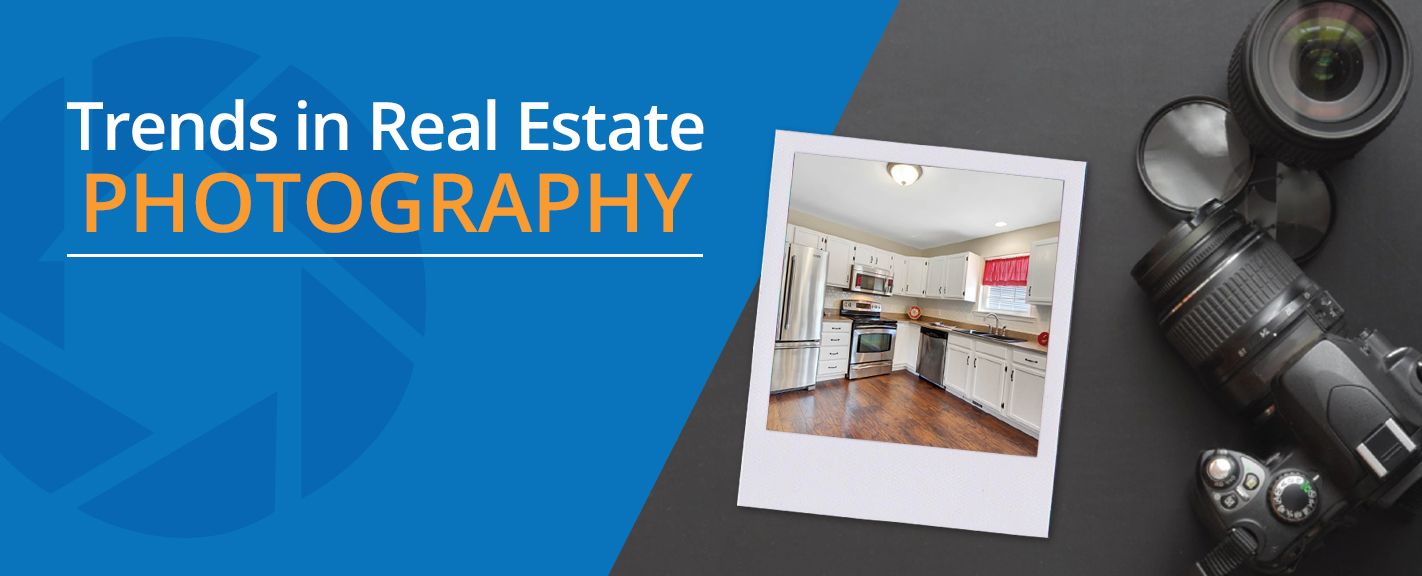
Table of Contents
- Photography Trends in Real Estate You Should Know
- How Does Aerial Photography Work?
- Benefits of Aerial Photography
- What Are Mobile-Ready Images?
- The Benefits of Using Mobile-Ready Images
- How Do 3-D Virtual Tours and Video Walkthroughs Work?
- The Benefits of 3-D Virtual Tours and Video Walkthroughs
- How Can Real Estate Agents Use Social Media?
- The Benefits of Social Media
- How Does Virtual Staging Work?
- The Benefits of Virtual Staging
- How You Can Make the Most of the Internet and Real Estate Photography Trends
Real estate and real estate marketing have changed. While the vast majority of buyers — 87% — still work with an agent when looking for a home, many are also turning to digital sources, such as social media and websites, to learn as much as they can about a property. About 44% of home buyers started their search for a house on the Internet in 2018.
Images and visuals are a major part of online real estate marketing. As more and more people begin their search for the perfect home online, it’s essential for real estate agents to offer their sellers ways to make a listing stand out. The latest real estate photography trends not only grab the attention of potential buyers, but they also help a home put its best foot forward.
Photography Trends in Real Estate You Should Know
Real estate marketing is always evolving, and trends come and go. To make your listings stand out and get noticed, it’s worth getting familiar with some of today’s biggest trends in real estate photography. Finding a way to incorporate one or all of the following trends into your listings will help you find more buyers, make your listing more competitive and ideally, help you sell a house more quickly.
1. Aerial Photography
Aerial photography captures images of a home and the surrounding area from above. The use of aerial photography lets buyers see the “big picture” when it comes to a home. Not only do they get to see the house and the land surrounding it from up high, but they can also see nearby amenities, such as a local park, a shopping center within walking distance and area highways.
Aerial photography is a trend that’s on the upswing and isn’t widely used yet. One survey found that just 11% of real estate agents use aerial photography. Offering the service to the sellers you work with can be a way to attract more listings and can help set you and your real estate business apart in a crowded field.
How Does Aerial Photography Work?
Taking pictures from overhead no longer requires you and a photographer to hire a helicopter or plane and to fly high into the sky. Instead, a photographer uses a Small Unmanned Aircraft, also called a drone, to capture the photos and video. The drone is remote controlled and carries a small camera that is stabilized with a gyroscope so the photos and videos will be in focus. It flies over the area, capturing 15 photos per session.
The person operating the drone on the ground usually has a first-person view of the photos and video the device is taking, which helps ensure the images are top-quality and that the property is being showcased and captured from the best angles and with the best light.
Benefits of Aerial Photography
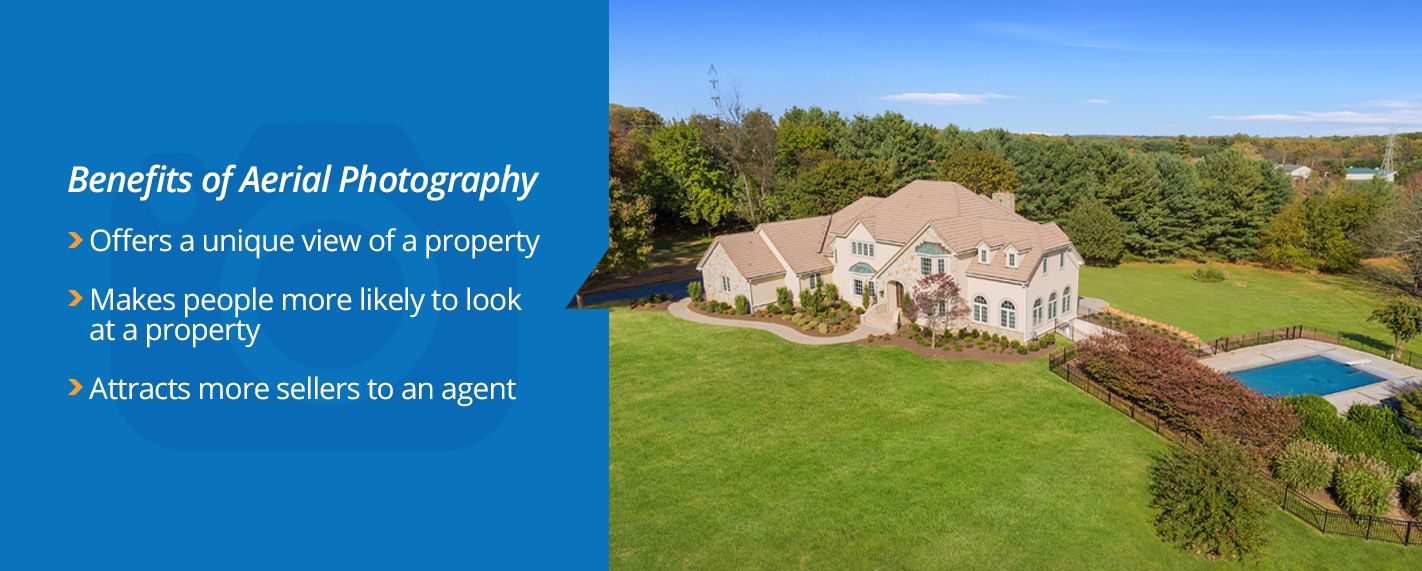
Aerial photography offers multiple benefits to sellers and to real estate agents who provide it:
- Offers a unique view of a property: Pictures and video taken from up above provide a view of the house and property that people wouldn’t ordinarily get. Drone photography also gives viewers an idea of how a property is situated and how close it is to amenities and other features.
- Makes people more likely to look at a property: There are a lot of listings online, and many properties are clamoring for the attention of home buyers. Including aerial photography with your listings makes them stand out and makes people more likely to check out what you have to offer.
- Attracts more sellers to an agent: Why should sellers work with you as their listing agent? Offering aerial photography, when others in your area aren’t, is one way to differentiate your business and make your services more attractive to people who are trying to sell their homes.
2. Mobile-Ready Images
People aren’t just looking for properties online these days. They are also likely to be researching properties using a mobile device, such as a tablet or smartphone. More than 70% of buyers use either a mobile app or access a website on their mobile device to find out more about a property. Mobile device use is particularly popular among younger home buyers, with Millennial buyers being twice as likely to use a smartphone or tablet as Baby Boomers.
More and more people are looking at properties on a mobile device. Google also encourages developers and businesses to make their websites mobile-friendly, to better meet the needs of an increasingly mobile audience. Images and websites that aren’t mobile optimized are less likely to show up in search results, which can mean that fewer people are likely to see your listings.
What Are Mobile-Ready Images?
Mobile-ready or mobile-optimized images are photos that load quickly on a mobile device. Mobile-optimized images should be responsive, meaning that they adjust their size to fit the size of a person’s screen. When an image isn’t responsive, it might take up more than the screen’s size, so that a person has to scroll or move the image about to see the full picture. Photos that aren’t mobile-optimized might look out-of-focus on one device and sharp on another.
People using mobile devices want pages and information to load quickly. They don’t have time to wait around for images to appear. For that reason, mobile-ready photos need to be lightweight enough to load quickly, without sacrificing image quality.
The Benefits of Using Mobile-Ready Images
Making sure that any images you use with your online listings are mobile-optimized means the listing is more likely to grab the attention of buyers and keep that attention. The last thing you want is for people to pull up your listing online, only to navigate away from the page because it takes too long for images to load.
3. 3-D Virtual Tours and Video Walkthroughs
Flat, two-dimensional videos and images are so 20th century. If you want potential buyers to feel immersed in the property you’re listing, without having to step foot inside of it, you want to offer sellers the option of adding 3-D virtual tours and walkthrough videos.
How Do 3-D Virtual Tours and Video Walkthroughs Work?
3-D virtual tours transform still images of the home into a realistic computer simulation. A 3-D virtual tour transforms the home into a dollhouse and gives viewers the option of navigating from room to room. Interested buyers can navigate through the home at any time, using a computer or mobile device. There’s also the option of using virtual reality headsets to help a viewer feel as if they are walking through the house.
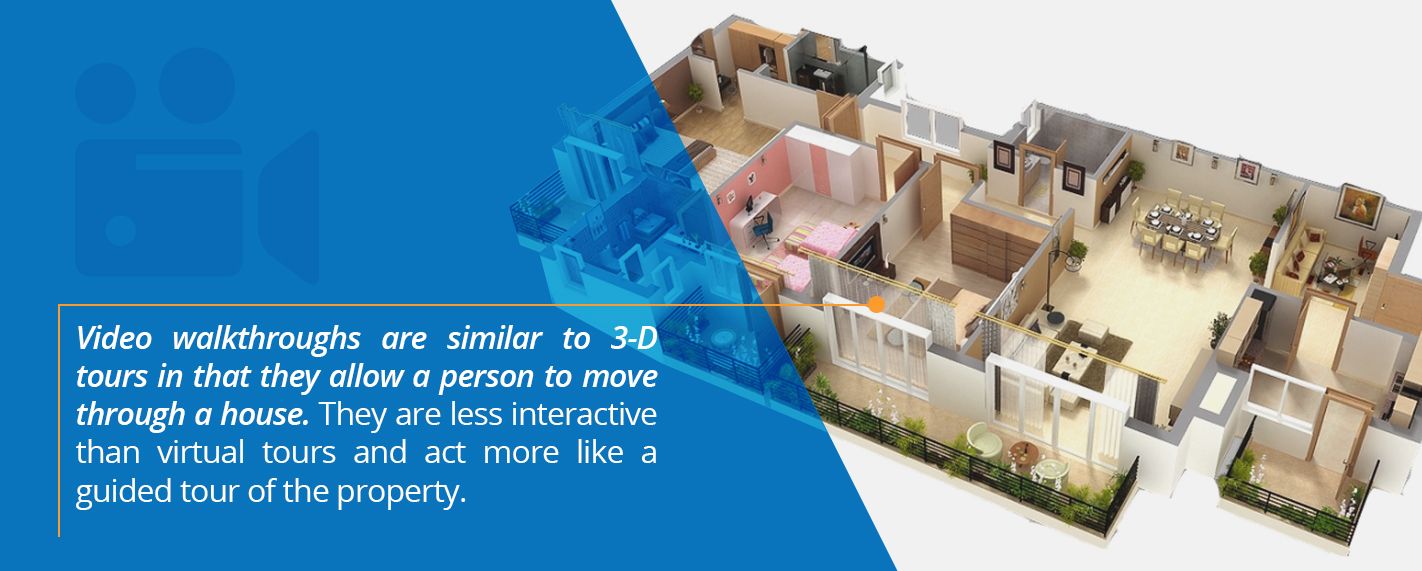
Video walkthroughs are similar to 3-D tours in that they allow a person to move through a house. They are less interactive than virtual tours and act more like a guided tour of the property. The video travels from room to room of a property, helping the property come to life.
The Benefits of 3-D Virtual Tours and Video Walkthroughs
People love virtual tours and video walkthroughs of properties. Here are a few benefits of using one or both in your listings:
- Appeal to buyers: Nearly half of all buyers found virtual tours to be very useful when they were gathering information about a property. Virtual tours are particularly popular among older generations. Nearly 40% of buyers used online video when gathering information about a home. Listings with virtual tours are more likely to get views than listings without tours.
- Cost-effective: It doesn’t cost much to create and add a virtual tour or walkthrough video to a listing. In many cases, the cost is recouped by having the house spend less time on the market or sell for a higher price.
- Help you win more listings: Sellers want to work with real estate agents who go above and beyond. Offering special perks such as the creation of virtual tours or video walkthroughs to your clients will help to make you a more attractive agent to work with.
4. Social Media Posts and Shares
Billions of people around the world use social media. In the U.S., nearly 70% of adults use Facebook, and smaller percentages are on platforms such as Instagram, Snapchat and Pinterest. Social media is also popular with real estate agents. Around three-quarters of agents say that they use it for professional reasons. More than a quarter of real estate agents rated social media as one of the most valuable technology tools over the past 12 months. Among agents, the three most popular platforms are Facebook, LinkedIn and Instagram.
How Can Real Estate Agents Use Social Media?
If you haven’t already started using it, there are many ways that you can put social media to use to promote your listings. First, social media lets you share photos of your listings, as well as walk-through videos and virtual tours. Once you’ve shared the photos and videos on your social media page, you can interact and engage with anyone who likes or comments on them. Sharing videos and photographs can be particularly beneficial on Facebook and Instagram.
You can use social media for more than simply sharing real estate photography. You can also create posts that offer valuable information to home buyers or tips for people looking to sell their homes. Many platforms have built-in messaging features that let you get in direct contact with interested sellers or buyers.
The Benefits of Social Media
Hands down, using social media is an excellent way to get leads. About 47% of real estate agents say that social platforms provide them with high-quality leads.
Another benefit of social media is that it can help to expose your listings to people who wouldn’t otherwise see them. Most people don’t spend their days browsing the multiple listing service, but the average person is likely to spend at least a few minutes on social media each day.
5. Virtual Staging
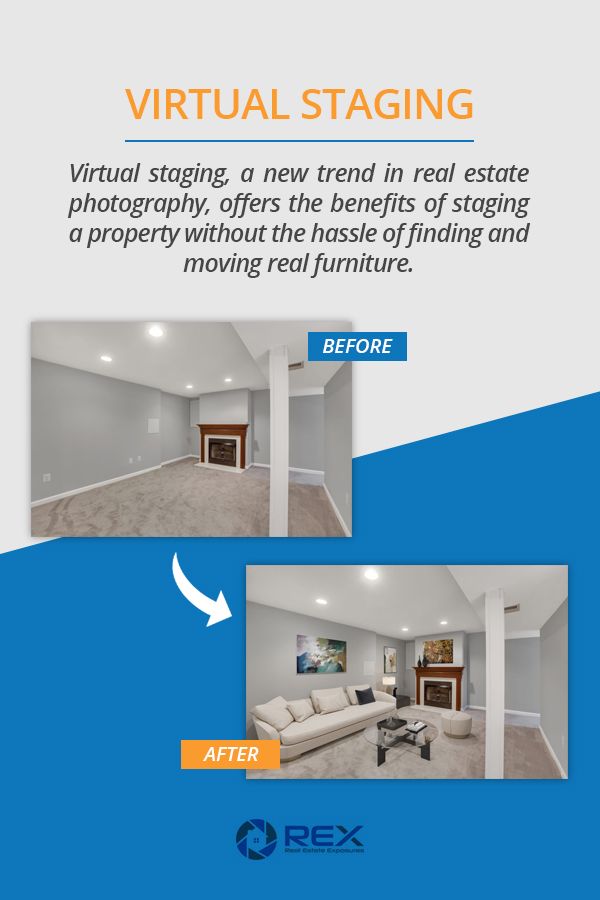
Staging a home can help it sell more quickly and for a higher price. But staging home often involves finding furniture to move into the house and can require you to hire a professional home stager to put everything together. Virtual staging, a new trend in real estate photography, offers the benefits of staging a property without the hassle of finding and moving real furniture.
How Does Virtual Staging Work?
Virtual staging transforms an empty room into a tastefully furnished and decorated one. The first step is to take photos of the interior of the house. The rooms should be empty. Next, you or the seller can choose the photos you want to use and pick the style of furniture to use as part of the staging. Photo editors add the furniture and decor to the images of the room, then finalize the images so that you download them and share on social media and on your online listing.
The Benefits of Virtual Staging
Virtual staging offers several benefits to real estate agents and sellers. The benefits include:
- More cost-effective than traditional staging: The median amount listing agents spend on traditional staging is $400. Meanwhile, virtual staging costs just $29 per image.
- Helps pique buyer interest in a house: Staging a home can help buyers see themselves living in the property and can also change a buyer’s perception of a home. When buyers view beautifully staged images of a home online, it can make them more interested in the property and more likely to want to schedule a viewing.
- Helps you sell homes more quickly: Virtual staging can help your listings sell more quickly, as it typically leads to increased interest in and demand for a property.
6. Buyers Are Searching for Homes Online
More and more, buyers are starting their search for a home online or continuing their search online. About 44% of buyers began their home search online in 2018 and the vast majority — over 90% — used the Internet at some point in their search process. Many of those buyers have stated that they find photos offered on websites or in listings to be very helpful to their home search.
How You Can Make the Most of the Internet and Real Estate Photography Trends
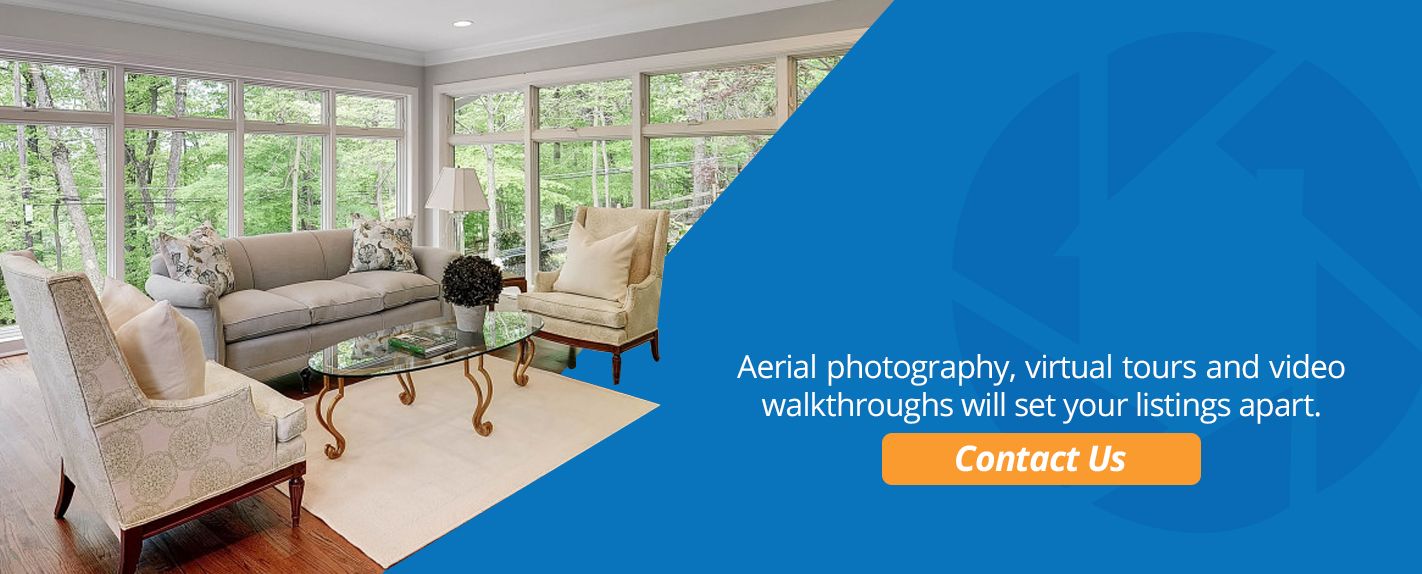
Using the Internet to get information about a house or to find out more about the home buying process isn’t a real estate trend that’s likely to go away anytime soon. Fortunately, there are many ways you can use online photos and information to better connect with buyers and to make them want to see your properties.
Using newer formats, such as aerial photography, virtual tours and video walkthroughs will help you showcase your listings to the best of their abilities and will give your listings something that sets them apart. Marketing your listings using image-centric social media sites such as Instagram and Facebook can also give you an edge. When it comes to taking photos of your listings, remember that you don’t have to do everything on your own.
Real Estate Exposures offers premium photography services in Delaware, Maryland, New Jersey, Pennsylvania, Virginia and Washington, D.C. We also provide “on-trend” services that can make your listings stand out, such as aerial photography and virtual tours. Call us now at 717-687-2289 to book a photo session, or contact us online to get answers to all your questions about professional real estate photography.
Recent Blogs

April 24, 2024
Real Estate Exposures Unveils ListingPix

May 23, 2023
The Power of Visual Storytelling: How Professional Real Estate Photography Can Boost Your Sales

May 19, 2019
Networking Tips for Real Estate Agents

May 11, 2019


